|
Ten years ago a Northern author called David Peace emerged with a book called 1974. It was set at that time in Yorkshire and dealt with corruption of every sort, told from the perspective of a young journalist. It was brutal, hard-hitting and heralded as the future of British crime fiction. He followed this with three sequels, all of which received similarly good reviews.
This year Channel 4 screened a trilogy of feature length films adapting Peace's quartet and were similarly strongly reviewed. Monday saw the release of these in a DVD set, I have been assigned to write the review...
Eddie Dunford is young, arrogant and hungry for a good story. Assigned to investigate the disappearance of a young girl, Dunford is thrown into a world of corruption, conspiracy and violence, unravelling crimes he wishes he had left buried.
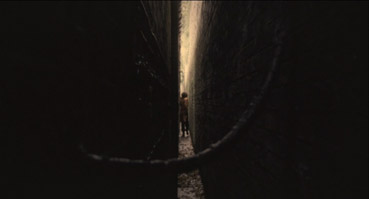
Okay, this is no highly original concept. This is film noir. But it is an intelligent take on the 1970s conspiracy thriller also. It is an unsentimental and unflinching look at a time in recent history that seems so near and yet so far from today. Casual racism, sexism and police brutality are things we like to think no longer exist in this civilised society, but deep down we know they do. That's why this hits a nerve and a tone so perfectly. As Dunford goes about his business we see the world through his eyes, and it's not a pretty sight.
Maybe there is a stigma attached to conveying the North of England as a drab, grey and foreboding place and it has become somewhat of a stereotype, but this is a story that needs the dark imagery, and although the horrors of the time might be exaggerated for dramatic purposes, that is not to say they are not grounded in truth, making it all the more disturbing. The language is strong and visceral, the script sharp.
Director, Julian Jarrold, creates a bleak and paranoid vision of the North with beautifully shot claustrophobia, using the locations to great effect. The straight lines and bold angles of '70s architecture are utilised to create division between character and environment, outdoor shots are murky or foggy, indoors there is always a fine film of cigarette smoke. Conversations are shot in intense, sometimes blurry close ups. This smudging of image reflects the blurring of the edges of morality, of truth, as well as the drunken and beaten haze Dunford staggers through towards the end of the film.
The speed of the narrative is as unrelenting as the setting and cinematography, somehow managing to move at a fast pace but still having a gentle and moody rhythm. Although there are some holes in the plot, they are purposefully left to be filled by the sequels in the series. This leaves the audience of Red Riding, Part One strangely satisfied and a little violated, but still wanting more.
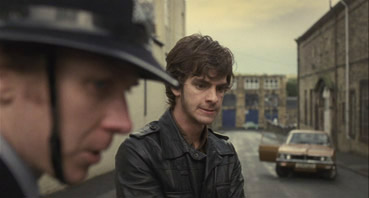
The performances are great across the board, as they should be with so much talent brought in. The accolades largely go to Andrew Garfield as Dunford, as the film relies on his central performance to hook the audience into the story, but support from David Morrissey and Warren Clarke as the dodgy police bosses are solid and brooding, with Sean Harris as Sgt. Craven purely terrifying in his unflinching dishing out of punishment Yorkshire-style (the first to utter the refrain to recur throughout the trilogy "This is the North, where we do what we want!"). Peter Mullan makes a short but tantalising appearance, to be expanded on in the sequels. Also Sean Bean as the villain of the piece is surprisingly charismatic and nasty, a world away from Sharpe!
The second of the trilogy sees outsider Assistant Chief Constable Peter Hunter (Paddy Considine) head up the Yorkshire Ripper investigation after several unsuccessful attempts on the case by local law enforcement. Hunter is strong but gentle and honest, qualities that make him unpopular with the department he finds himself working with, who all seem suspiciously defensive and uncooperative towards him. Hunter is also trying to equate home life with police work, and an unresolved affair with a work colleague is a further distraction for him. As the investigation progresses and Hunter finds out there is a murder not compatible with the Ripper that has been left unsolved, things get decidedly uglier for him.
Considine is fabulous, giving a quietly assured performance as a good man with flaws he wished he did not have. Giving such a character infidelity issues creates that imperfection that stops him from seeming too much like a squeaky clean good guy. In this aspect he is similar to Eddie Dunford in 1974, although besides his drive to get to the bottom of things, Hunter is very different from the first protagonist. He is what Eddie could have become, a domestic man with a wife and a good career, older and more mature but still with a passion for the truth and for women that he can't ignore. Many of the same characters return in this film from the first one as it is their department all three parts hinge around. An informant rent-boy called BJ reappears and David Morrissey and Peter Mullan both have slightly larger roles in this sequel, but it is Sean Harris as Craven who really gives Considine a run for his money – the scenes they share are electric with tension as the two sides of the police coin butt heads. Venom is spat by Craven and defused by Hunter to fantastic effect.
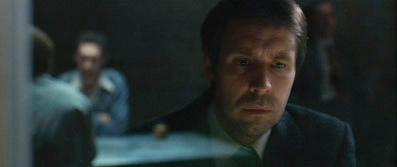
The pace of this film is slower and more thoughtful than its predecessor, reflecting the protagonists' nature, and director James Marsh opts for a slightly less stylistic approach to that of 1974. Focusing around a real murder investigation and using a more overt score as well as archive footage of the time, 1980 sometimes seems a Summer of Sam to 1974's Chinatown. Yet the conspiracy here is deepening and every step the conscientious Hunter takes brings him closer to the truth and closer to the grave.
The sexism touched upon in the first film is discussed more overtly in this one, with Hunters colleague and former mistress constantly leered at by Craven.
The conclusion of this episode is no less shocking and brutal than the last, with police corruption well and truly dominant and all powerful, with as little respect within the force as outside it. More light is shed in flashback form on the previous film but 1980 still stands out as a good piece of work in its own right.
The final installment of Red Riding has much to do. It must tie up loose ends and deliver a concluding chapter worthy of the others and the original novels. Can it be done or will this great British thriller trilogy stumble at the last hurdle?
1983 sees murders of small girls that frighteningly mirror the ones Eddie Dunford investigated nine years previously. There are more devastated parents at press conferences, more footage of lone girls walking toward a home, unknowing of their fate. This isn't copying the first part of the trilogy, this is reinforcing the repetition of horrible crime that hit us every day in the papers and on the news, and as this is the closest film to today this resonates all the stronger.
This time we follow two main characters, weaving an ever more complex set of narrative threads. The theme of family bereavement is also echoed from the first film in the beginning of John Piggott's story. New to the saga, Piggott (Mark Addy) is a kind hearted lawyer who has an interest in helping Michael Myshkin, the mentally handicapped man jailed for the murders in 1974. Meanwhile David Morrissey's Maurice Jobson is assigned to the case of the new murders – a man with a past that haunts him, Jobson wants to do the right thing for once in his career.
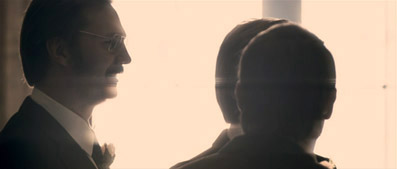
Both leads are good but Morrissey is outstanding, looking every inch a man broken by the things he's seen and done. Finally Mullan's strangely helpful vicar comes into his own and the ending reveals his connection to the plots and conspiracies created by these questionable men. Daniel Mays as Myshkin is able to flex his acting muscles in this episode, not really given the opportunity in his one scene in 1974, and does a fine and disturbing job as a crucial link in the chain of horrors.
There is a whiff of the supernatural and ethereal to this final part, backed by colour bleeding and light play that really make the most of the High Definition cameras used in the shoot. Light from the background cuts into the foreground, giving a blinded-by-the-sun dazed feel to the mise-en-scene. The plot jumps from flashback to present day a little erratically at times, and the dual perspective used confuses things more than the focalised first person narratives of the first two parts. The story seems to swim in a ghostlike trance that is hinted at in both previous films, but never indulged in as much as 1983. This seems to mostly come from BJs perspective – the little-boy-lost of the story, it is his haunting voiceover that frames this concluding chapter. It comes down to personal taste whether these surreal and stylistic methods work for you, but personally I find them visually engaging and also quite poetic, the only real use of the more poetic and lyrical prose Peace used in his original books. As with the other films the costume and location work is top notch and there is tremendous attention to detail in maturing the characters and aging the locations. Coming back to narrative, the piece does tie up loose ends and concludes in an almost optimistic way compared to the first parts, but before that the audience is submerged in this dark world every bit as much as in the other films. Torture, brutality and deception must be navigated before redemption.
The three films don't just have different directors, but also employed different recording formats and aspect ratios. 1974 was shot on film – Super-16 if I remember right – and is framed 1.85:1. The anamorphic transfer here is generally impressive, having a fine level of detail, very well balanced contrast and a colour scheme that is both natural and yet at the same time suggestive of the place and time without excessive use of colour filtration – the drab, toned-down look appears to have been created as much through production design and costume as lighting and colour timing. There are some slightly muddier looking interiors, but this is both intentional and appropriate.
For the second film the aspect ratio switches to 2.35:1 and the contrast is frequently softened, the result of a stylistic choice that lightens the black levels and effects some subtle alterations to the colour scheme, adding a slightly orange hue to night scenes, of which there are many. Daytime exteriors look fine, though. The intermittent contrast drop can make the image seem a little washed out in darker scenes, but this does appear to be deliberate and is consistent throughout the film.
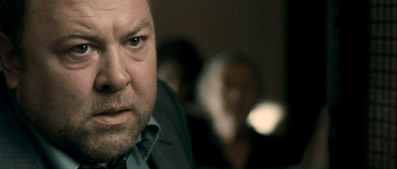
Despite being shot on HD, the format's standard 1.78:1 ratio has been compositionally reframed on part 3 to 2.35:1. The transfer is pristine, having crisp contrast and an excellent level of detail and that rather pleasing HD look that sits somewhere between film and video. As is the way with most digital media, the contrast range does not quite have the finesse of film, resulting in occasional loss of detail in shadows and highlights, but few will find that cause for complaint here. Night-time black levels are particularly solid.
There's not much to choose between the stereo and surround tracks – all are crystal clear and boast a strong dynamic range, though thunder definitely gets a little extra oomph on the 5.1. Music does make its way to the surrounds, but not as obviously as on the previous disc.Stereo 2.0 and 5.1 surround tracks are available on all three discs, but the surrounds are really only put to work by the score. Frontal separation is clear on both tracks and the clarity and dynamic range are excellent.
Rather a short list of extras on disc 1, which are an interview with Julian Jarrold (11:25), who discusses topics from his attraction to the script to the casting of Garfield and the influence 1970s motion pictures had on his direction. It all seems a bit too brief and I would have liked to hear more from him, maybe on the likes of a commentary track. An interview or two from other crew and some cast would have been nice. The only other additions to this are three deleted scenes (9:19). These all seem to be scenes that connected the TV adaptation more closely with the book. The first one sees Dunford with his father's watch, an important symbol of the novel, but one never featured in the finished film. The second has Eddie looking through the abandoned house of the Myshkin family and finding a drowned cat in the bathtub and a comic book created my Michael Myshkin. This is also lifted straight out of the novel but must have seemed unnecessary when editing the film. The third is an alternative ending, bleak and ambiguous – probably too much so to make it into the final cut. What is a shame here is that there is no commentary or information on why these scenes were not included in the film.
A slightly less anaemic set of features are included on disc 2, beginning with a pretty good Making of 1980 featurette (18:46). This has interviews with executive producer Andrew Eaton, director James Marsh, actor Paddy Considine and writer for all three films Toni Grisoni (to name a few), weaved together with interesting on-set footage of the construction of some scenes from 1980. Everyone has their voice heard and all build a solid picture of the goals and ideas of the film, but it is really just a snapshot – a longer documentary would have really satisfied me. There are also five deleted scenes (6:46) consisting of Hunter visiting a shed where he keeps all his work on the Yorkshire Ripper, a missing interrogation (actually a really nice scene but would not fit in with the overriding narrative and rhythm), a touching moment between Hunter and his wife after their home is burnt down, and an even more tender and quite surprising scene between Sutcliffe and his wife. The final scene is one long shot showing the suicide of one of the peripheral characters, a moment of tragedy too far I expect. Once again a pretty small set of features, redeemed slightly by the fascinating if short 'making of' featurette.
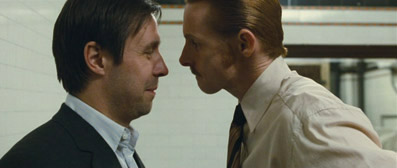
Disc 3 follows the same pattern as the other two discs in the set with a behind the scenes featurette (6:42) similar to the making-of on Red Riding, Part Two but shorter. It has location footage and interviews with the makeup artist and production designer who talk about the era, the costume and settings and shooting on HD. Actor Mark Addy discusses the writing and the darkness of the themes within the piece and producer Eaton appears briefly. Disappointingly short. Then there are a set of eight deleted scenes (the largest in the package, 7:50). The first is Mullan's character with Myshkin, just fleshing out his role really, but the second shows how the ending of the film could have taken a very different route. Interestingly, the third scene is a shot almost directly lifted from the Francis Bacon biopic Love is The Devil involving multiple shaving mirrors – it looks great actually, but not original! The rest of the scenes are of very little use. Unfortunately there are no descriptions or anything to put any of these scenes in context with the finished film, so like with the other discs one is expected to try and piece it together oneself. A guide to these scenes or a commentary track over them would have been an invaluable addition.
This is a rare thing to see on British television, a trilogy of films created specifically for TV with all the hallmarks of real quality cinema. These films would not have seemed out of place in theatres, spaced a year or two apart, with a big marketing campaign alongside it. In some ways I don't understand why they didn't do just that. Generally, though, I think it is a great thing, just the bold push needed to heave our television drama out of mediocrity and compete with the big boys across the water.
Separate directors bring their own individual visions to Peace's books that conform to the overall tone of the series, with the adaptation credit going to one man, Toni Grisoni. Having one person write all three films brings a unity to the trilogy that it really needed considering its labyrinthine plot and large cast of characters, all of whom are on the top of their game.
At the heart of this series, as with Peace's books, is grief, betrayal, murder, paedophilia and rape. It is a pitch black thriller story that owes as much to American cinema of the 1970s and the paranoia of Orwell's 1984 to the council flats and rundown neighbourhoods of 70s-80s Yorkshire. Its timeless message says corruption and evil are at the heart of humanity no matter the era or the area, and if good men stand back and ignore it salvation will forever be at a distance.
A sadly meagre amount of features lets down the DVD release of a quite brilliant three-part series. We need to look at how the US package their TV drama as well as how they create it in order to really get up there with the big boys (e.g. each season of the The Wire has episode commentary tracks and documentaries). Also it would have been nice to hear what David Peace himself thought of these adaptations, he is notable by his absence here.
To hell with it, buy it anyway just for the films. And read the books too, Peace's writing is the solid and brilliant foundation for these works.
|